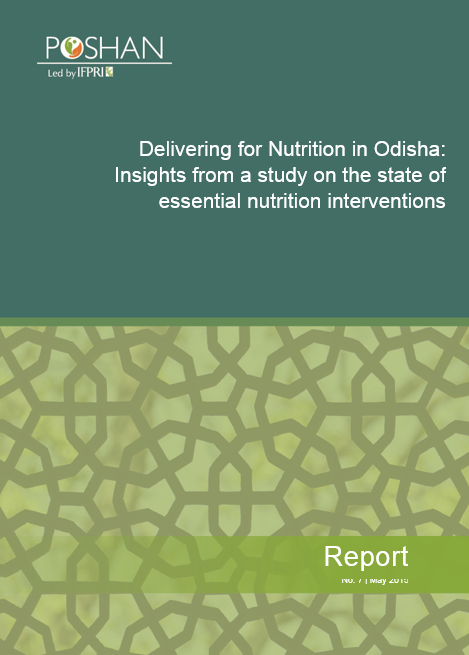Two national programs in India ─ the Integrated Child Development Services (ICDS) and the National Rural Health Mission (NRHM) ─ have been designed to cover and address a set of recommended nutrition-specific interventions. Frontline workers (FLWs) from both programs are expected to work together to deliver these interventions. There are, however, challenges to working across sectors, and the lack of or poor coordination may inevitably lead to insufficient coverage, inconsistent data reporting, and work redundancy.
In recent years, the government of Odisha has taken steps to enhance service coverage and foster coordination between the ICDS and health programs. POSHAN recently conducted a mixed-method study, to examine the state of delivery and use of ten essential nutrition interventions (ENIs) and the role of intersectoral coordination in their delivery in three districts of Odisha (Jagatsinghpur, Keonjhar and Kalahandi). In each district, the authors selected four blocks (n=12) and 25 villages (n=300) from each block. One Anganwadi Center (AWC) per village, with an Anganwadi Worker (AWW), along with the Accredited Social Health Activist (ASHA) and the Auxiliary Nurse Midwife (ANM) working in the same area were included in the study. Also, four households (two with children 0-5.9 months and two with children 6-23.9 months) were randomly selected for the study. Semi-structured interviews were conducted with ICDS and health staff to understand coordination of service delivery, roles, and work responsibilities. Household and frontline worker surveys were conducted to gather data on a variety of topics including household conditions, exposure to services, and knowledge of infant and young child feeding (IYCF), and FLW training, knowledge and types of services provided.
 This report provides descriptive summaries on the exposure to interventions among mothers and children, provision of interventions, and extent of coordination in service delivery among FLWs. Here are some highlights from the study:
This report provides descriptive summaries on the exposure to interventions among mothers and children, provision of interventions, and extent of coordination in service delivery among FLWs. Here are some highlights from the study:
─ Exposure to interventions during pregnancy was higher than the exposure to interventions during 0-6 months and 6-24 months after birth.
─ Exposure to ENIs at Village Health and Nutrition Days (VHNDs) was very high among those in attendance, but only 59% of target mothers attended VHNDs.
─ Exposure to ENIs at home was low. Although 90 percent of mothers were visited by FLWs in the last three months, less than a third of mothers reported receiving any IYCF counseling during home visits.
─ Positive results on coordination among FLWs, with nearly all of the FLWs reporting on always coordinating to deliver the interventions, usually by planning and implementing together.
Based on these research findings, the authors recommend to identify and address the major supply- and demand-side constraints to participation in VHNDs and the reasons for missed opportunities for IYCF counseling during home visits, ensure role clarity among FLWs, harmonize key health and nutrition messages, target and reach low income households, invest in efforts to address the underlying determinants of malnutrition, and lastly, build in mechanisms for monitoring and operations research to assess and track the progress of service delivery and exposure to the ENIs.



